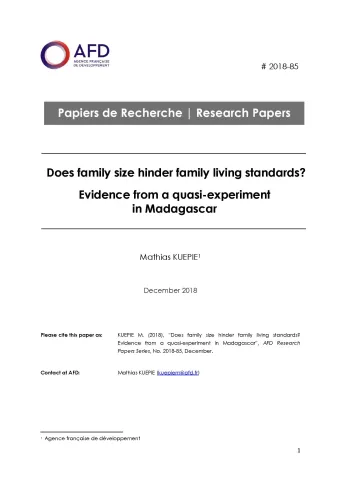Share the page
Does family size hinder family living standards? Evidence from a quasi-experiment in Madagascar
Published on

In this paper we try to identify the causal impact of fertility on household welfare in Madagascar using gender of the two first-born children as a source of exogenous variation. The issue of the link between fertility and economic well-being has been widely treated in the literature but we improve on existing studies through some methodological innovations. First of all, instead of using instrumental linear regressions, we rely on instrumental quantile regressions techniques, which have two main advantages over the IV linear regressions: the first is that they are less sensitive to extreme values and outliers. The second added value is that quantile regressions allow the exploration of the heterogeneity of the potential effect of fertility on different parts of the living standards distribution and not only at the mean or at the poverty-line cutoff as is generally done in the literature. Lastly and more importantly, given the richness of our data, we are able to disentangle the living standard indicator in different expenditures items: food expenditures, durable goods expenditures, human capital, etc., and test whether households facing exogenous fertility increase reduce their living standards more in some dimensions than in the others. The results show that an exogenous increase in fertility reduces total consumption per capita, and that this result is statistically significant. But its magnitude is less than that of a regression without controlling for endogeneity. When the total consumption per capita is broken down into different items (food, human capital, housing and durable goods), analyses show that all consumption items are affected by the impact of the fertility burden, and that this detrimental effect occurs at any quantile of living standard distribution. These results should be understood in the context of Madagascar, characterized by an endemic high level of poverty that affects nearly three quarters of the population.
Useful Information
-
Coordinators
-
Mathias KUEPIE
-
Edition
-
85
-
Number of pages
-
31
-
ISSN
-
2492-2846
-
Collection
-
Research Papers
